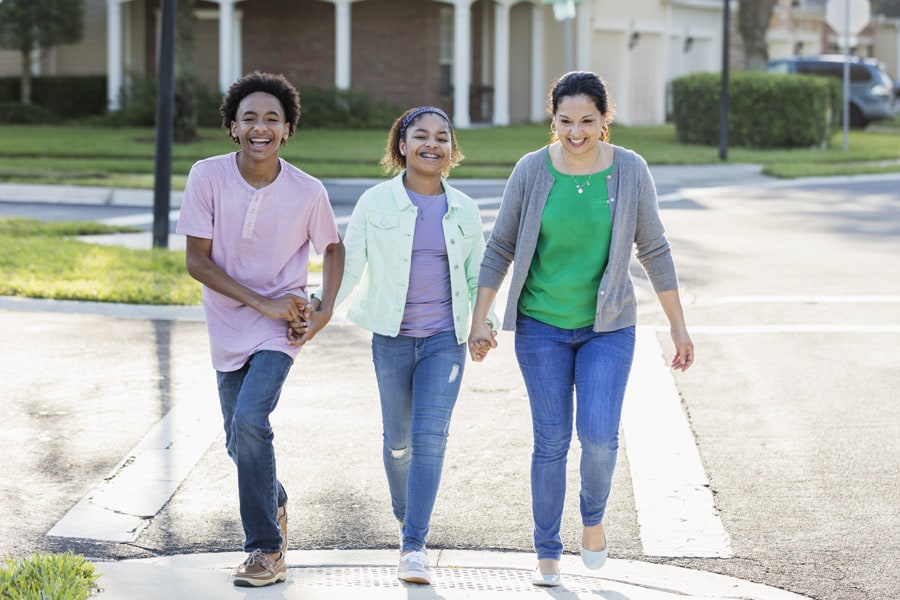Tricks to Manage Halloween Treats
Before you know it, Halloween will be here, bringing ghouls galore to your door! The preparation leading up to this day can be full of fun, excitement and probably a little stress.
Will there be a last-minute costume change? Where will we trick-or-treat? Should we offer non-candy Halloween treats? And the biggest question and sometimes concern… what are we going to do with leftover candy? Don’t let the treats spook you! We’re here to help you and your family build a positive relationship with candy this season.
In this article:

Offer candy and non-candy Halloween treats
Giving out candy is totally fine, but consider mixing it up with non-candy Halloween treats too! What kid doesn’t like small trinket toys?
Try adding these non-candy Halloween treats to your bowl this year:
- Glow-in-the-dark bracelets, rings, necklaces, etc. These are great for safety as well as fun!
- Bouncy balls
- Bubbles
- Play-Doh/Silly Putty
- Mini Slinkys
- Sticky hands
- Temporary tattoos
- Silly straws
As with all things, use caution when giving away items that could be a choking hazard for babies and toddlers.
Non-food treats are a great option for children with food allergies. If your child has food allergies, check out the Teal Pumpkin Project for more information.

Grab a bite before heading out
The real trick to a delightful Halloween is not adding hanger (feeling grumpy or irritable when you’re hungry) to the holiday excitement. Sometimes we get so caught up in prepping costumes, walking routes and everything else that we forget to prepare our bodies for a long night of walking and running.
Before you head out the door, try out one of our quick dinner ideas or filling snack combinations.
Quick dinner ideas
- Rotisserie chicken rolled in a tortilla with cheese, salsa and lettuce. Round out the meal with an apple.
- Peanut butter and banana sandwich with some baby carrots and ranch for dipping.
- Toasted English muffin topped with marinara sauce and shredded mozzarella cheese. Round it out with a fruit cup.
Filling snack ideas
- Cottage cheese and canned peaches
- Yogurt topped with berries and crunchy cereal
- Sliced cucumber, pretzels and hummus for dipping
And don’t forget the water! Choose water or milk over sugary drinks with meals and snacks. And don’t forget water bottles to keep the whole family hydrated while trick-or-treating!

What to do with candy on Halloween night
A wonderful and important life lesson can come out of Halloween, and that’s learning how to develop a positive relationship with candy. Try these tips this Halloween to help your child start building positive food relationships:
- Allow time for excitement about candy. Your child just walked or ran all over the neighborhood to get all their candy! Let them have fun sorting, possibly trading with siblings and, of course, tasting.
- Candy time is snack time. While your child is sorting and eating candy let them know that this time is “snack time.” This is a great opportunity to offer other healthy food options along with their candy. Try: sliced apples and peanut butter, a mandarin orange, a glass of milk or water.
- When snack time is over, candy time is over. On this special night when your child is so excited about all their candy, try this:
- Don’t set a specific number amount of candy your child can eat.
- Instead, let them eat and taste what they want. As the caregiver, part of your role is to provide the routine.
- Give your child some notice that snack time is about to end when it’s time to get ready for bed.
- Try saying, “It’s time to get ready for bed! You can choose 2 more pieces of candy and then we will put it away until tomorrow.”
Shift your candy mindset
So many of us probably grew up thinking that candy is “bad” food. It’s full of sugar! It’ll make you gain weight! You’re “cheating” when you eat it!
If we grew up hearing food categorized this way, it makes sense that having a ton of Halloween candy in the house can be triggering. It’s normal for the candy rules we grew up with to follow us into adulthood. But it’s never too late to take steps to change our relationship with food.
This Halloween season, try to shift your thoughts and language when it comes to candy to help your child learn how to handle candy when it is all around us.
| When we say: | Our kids learn: |
|---|---|
| “I can't eat any candy. It’s just going to make me fat.” | Candy is bad. It will make me fat and being fat is bad. |
| “If you don’t get ready for bed now, I’m going to throw your candy away.” | If I don’t behave a certain way, I get food taken away from me. |
| “Parent tax! I’m taking some of your candy because I took you trick-or-treating.” | I must give people something when they do something for me. |
| Try saying: | Our kids learn: |
|---|---|
| “Let’s choose 2 pieces of candy to have with our lunch.” | I can eat candy and other foods together and it will be OK. |
| “It’s time to get ready for bed.” | My caregiver has set the routine and I am learning to follow it. |
| “I would love a piece of candy. Can you share with me?” | I am fine to share my candy because I know it will not get taken away. |

What to Do With Leftover Halloween Candy
Once Halloween is over, you may have bags and bowls of candy piling up in your house. There are a few different things you can do with leftover candy, but the most important thing to remember is setting kids up for a healthy relationship with candy.
Try implementing some of these positive strategies for what to do with leftover Halloween candy:
- Set clear expectations of what will happen with the candy after Halloween night. Many times, kids want to eat it all, sneak pieces, or hide and eat candy. They may do this because they’re afraid of being shamed or having candy taken away, given away or thrown away. This year, try keeping the candy in your house and letting your child know it will be there.
- Do not use candy to bribe, reward or punish kids. Using candy to get children to behave a certain way can have negative effects on their lifelong relationship with food.
- Allow candy at some meals and snacks. Getting candy on Halloween is like receiving gifts on other holidays. Your child will mostly likely be infatuated with it for some time, but eventually it will wear off. Let them have candy with some meals and snacks for a while—this will help make candy seem like it’s not special or “better” than any other food. Just remember: As the caregiver, you can set the limit on how many pieces are allowed with a meal and/or snack.
- Get creative. Sometimes there's just so much candy and we simply won’t be able to eat it all.
- Try using chocolate candy in cookies, brownies and pies. Encourage your child to spread the joy with neighbors or bring your baked goods to a community or family gathering.
- Melt hard candy in the oven and watch it turn into “stained glass.”
- Have fun with candy-themed STEM (science, technology, engineering, math) activities like creating candy slime, Skittles rainbows, gummy DNA and so much more!
Trying these tactics might feel scary or uncomfortable—that’s normal and OK! Even for grown-ups, it’s hard to try new things and make changes. (Especially when, for most of our lives, candy has been a “bad” food!) But using these strategies can help set up your child (and you) for a healthier relationship with food.
Halloween safety tips for families
Halloween festivities typically take place out on a street—and, often, in the dark. Keep these Halloween safety tips in mind:
- Shine bright. Wear glow-in-the-dark accessories or reflective gear so it’s easy for other people (especially drivers) to see your family in the dark. And bring a flashlight!
- Follow pedestrian safety rules. Hold little ones’ hands, teach them how to cross the street safely and warn them about talking to strangers. Make sure older kids trick-or-treat in groups and talk to them about staying alert while they’re out walking. Check out more pedestrian safety tips from our emergency department physicians.
- Be alert. Drive extra slow in residential areas during trick-or-treating times with all the children and families walking about.
- Be aware of choking hazards. Walking or running with candy can be a choking hazard. Instead of eating candy on the go, take a moment to enjoy some pieces together while sitting on the curb or standing in place. This way, you decrease choking risks and can also inspect the candy before eating.


